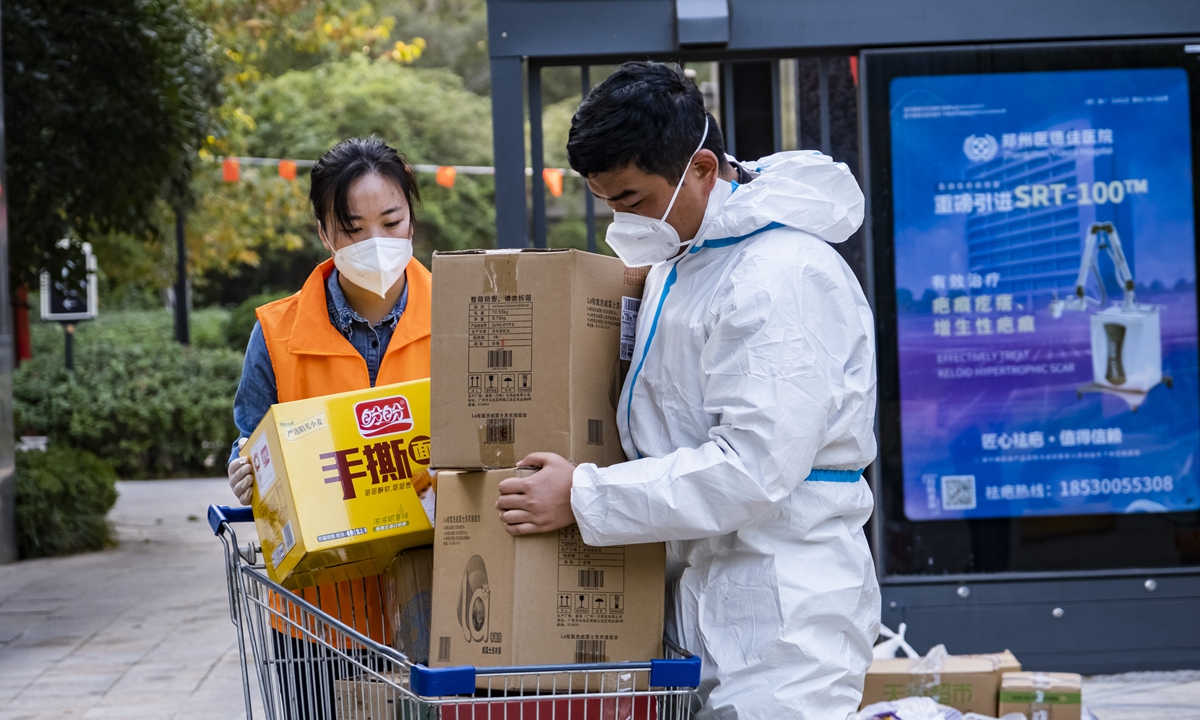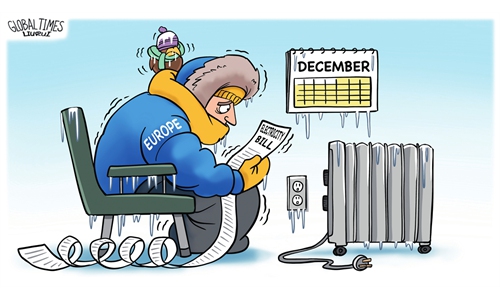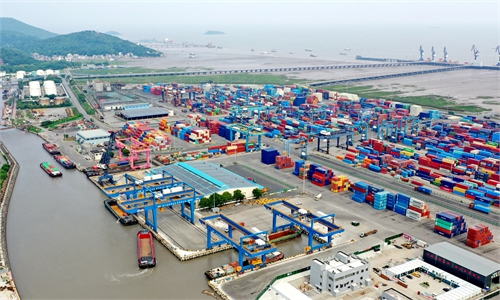Chinese local govts endeavor to address public concerns amid widening COVID outbreak

A community worker and a volunteer distributer daily supplies in a community in Zhengzhou, Central China's Henan Province, on October 22, 2022. Photo: VCG
Winter comes, not only bringing cold air across China, but also sparking a new wave of COVID-19 flare-ups in multiple provinces and regions with more than 1,000 new cases reported on Thursday nationwide for a third straight day, which triggered affected areas to double down on measures in an attempt to bring the outbreaks under control as soon as possible.
Unlike previous outbreaks in megacities including Shanghai in the spring, this time the virus has swept more medium-sized and small cities, which have poorer medical resources and less experience in virus detection and control. Drawing lessons from the three-year national epidemic battle, local governments are trying to address public concerns and endeavoring to control the flare-ups in a more targeted manner.
As Shanxi, Fujian and Qinghai provinces have seen a rapid development of the epidemic while Guangdong Province and the Inner Mongolia and Xinjiang Uygur autonomous regions have hit a plateau, the daily increase in local infections in the Chinese mainland remains high.
The National Health Commission reported on Thursday another 193 confirmed local cases in the mainland, lifting the existing total to 3,666 by the end of Wednesday. Also, 924 asymptomatic local cases were recorded on Wednesday.
Chinese medical experts and virologists said the outbreaks test local governance ability, stressed the importance of precise and targeted prevention and control measures, and avoiding a one-size-fits-all approach.
Xining, capital of Northwest China's Qinghai Province, which is under static management, is working to increase food supplies and stabilize the prices of daily necessities to guarantee residents' livelihoods.
The city detected 75 infections on Wednesday, bringing the total number during the past week to 166.
A major supplier of fresh food in the city - the Qinghai-Xizang (Tibet) Plateau Agricultural and Sideline Products Distribution Center - was closed after three cases were reported on October 20. Facing surging cases, Xining required local residents to stay at home from 12:30 pm on October 21.
Media reports said that some locals found it was difficult to buy vegetables and meat even as prices continued to surge, which triggered public outrage. In some areas identified as medium and high risk, some residents were reported to have encountered difficulties in seeing doctors.
In response, a local official said at the Wednesday press conference that they have set up four temporary wholesale points to deal with over 1,000 tons of vegetables daily for four consecutive days, although the supply of fruit is still challenging.
The wholesale points send food to supermarkets, fresh markets and stores around communities daily. Also, 39 fresh markets, 36 supermarkets and 161 vegetable outlets are open. Over 300 trucks are bringing vegetables to residents every day, Chen Xiaoping, an official in charge of logistical supply said at the press conference.
As of Tuesday, the city had stocks of 580 tons of vegetables, 19 tons of eggs, nearly 5,000 tons of rice and flour, and 1,400 tons of cooking oil, said the local official, noting that the transport and reserve of daily supplies can meet the demands of residents.
Inspection groups have been set up to monitor prices and crack down on illegal behavior to stabilize prices and guarantee market order. On Wednesday afternoon, three vegetable stores were penalized, local authorities said.
Zhengzhou, Central China's Henan Province, has seen a decrease in the number of new cases and effectively curbed the spread of the epidemic with five confirmed infections and 20 silent carriers reported on Thursday, local authorities said.
As a national transport hub, Zhengzhou suffered from this outbreak triggered by cases from outside Henan Province. The frequent personnel flows during the week-long National Day holidays in early October and the return of many students to their schools after the holiday have caused the virus to spread in multiple areas in the city, Zhengzhou epidemic control and prevention authorities said Thursday.
In addition, the infectious disease becomes active in the fall and winter, resulting in local mass virus transmission, the authorities explained.
The latest flare-up in Zhengzhou attracted wide attention after Foxconn said on Tuesday that its factory in Zhengzhou - the world's largest assembly plant for Apple's iPhones - had been hit.
A spokesperson for the firm was quoted by US financial news network CNBC as saying that operations and production at its Zhengzhou facility are "relatively stable with health and safety measures for employees being maintained."
Although some counties and districts in Zhengzhou have issued notices to restore normal life in some residential communities, the control measures in some areas are still strict. In response to public concerns, the local authorities explained on Thursday in a statement that in some communities, the control periods are long because some cases were detected after 7-10 days of infection.
In order to ensure the health of residents, the management measures should be strengthened in some communities with many close contacts. The authorities said that they will gradually open the communities in an orderly manner, according to the statement.
Civil servants, medical staff and other personnel working to provide basic urban operations in low-risk communities can enter and exit the communities with a green health code and a negative nucleic acid test taken within 24 hours, the statement said.
In view of the interruption of nucleic acid testing complained about by some local residents, the local government has ordered all districts and counties to meet the need for nucleic acid testing.
Considering that the virus continues to mutate, and the infectivity, transmission ability and immune escape ability are stronger, the domestic epidemic continues to show a situation of multi-point distribution and local outbreaks, and the pressure of prevention and control is increasing, medical experts said.
Curbing the virus' spread in these areas, especially those in Northwest China, is a big challenge, as increasing crowded indoor activity and winter can lead to cross-infections, Zhuang Shilihe, a Guangzhou-based medical expert who closely follows public health issues, told the Global Times on Thursday.
Yang Zhanqiu, a professor of the pathogen biology department at Wuhan University, believed that normalized anti-epidemic efforts are enough to deal with the flare-up, noting that in some areas, excessive anti-epidemic measures actually exposed the lazy political thinking of some local officials.
The virologist called on some local authorities and the public to treat the epidemic calmly, stressing the importance of early detection, early quarantine and treatment for infected cases and avoiding a one-size-fits-all approach.




